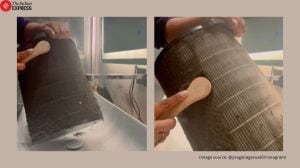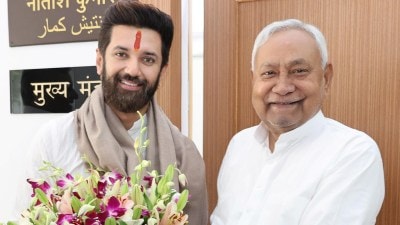Stay updated with the latest - Click here to follow us on Instagram
Masked Reality
After studying Indias two masked theatre forms,a new book makes a pitch for a legislation to preserve the countrys traditional art.
After studying Indias two masked theatre forms,a new book makes a pitch for a legislation to preserve the countrys traditional art.
The thought of giving up dancing horrifies Khirod Singh Munda,a Purulia Chhau exponent. If we stop dancing,we would be left without a soul, he says. For this 55-year-old considered to be one of the few artistes who have preserved the purity of this traditional art form dance is a way of life. Even though practising this art form for more than four decades has not been financially rewarding,he is hardly complaining. I dont need money to promote this art form. We cant attach monetary value to it, he says.
Though Mundas ideology and passion for art is more than evident,his words also hint at the problem this age-old art form has been encountering. Most of the Purulia Chhau dancers live in poverty and are caught in a debt trap. Chhau and Kutiyattam are two of the eight UNESCO recognised art forms of India. While Seraikella Chhau dancers understand the significance of this status and leverage it to their advantage,most of the Purulia Chhau dancers are unaware of it, says Shubha Srinivasan,the author of Masked Identities.
The book which has been put together in association with Observer Research Foundation (ORF),Asia Society,and INTACH seeks to identify and highlight Indias intangible culture heritage (ICH) such as oral traditions,languages,performing arts,social practices and traditional craftsmanship. More importantly,the book studies and analyses the steps taken by the government to preserve them,the problems faced by the artistes and comes up with recommendations to tackle them. While people understand that our many cultural expressions are vanishing,they do not comprehend the loss of identity,livelihoods and an avenue for sustainable development. The book shows ICH as a representative of identity,diversity and sustainable development, says Srinivasan. India has over 17 million traditional artistes and they can contribute up to seven per cent of the gross domestic product of India.
For this purpose,ORF chose two theatrical dance art forms that use masks. According to Srinivasan,masks are symbolic of a way of life. The book also keeps the reader visually engaged through a combination of performance photographs and those depicting artistes life. This allows the reader to realise that the life of artistes and artisans is not so glamorous behind the colourful costumes, says the author.
Kutiyattam of Kerala has to grapple with a unique problem of its own. It was the first Indian art form to get UNESCO recognition in 2001. After that,its artistes have mostly been creating shows in Sanskrit for outside audience. This has alienated the local community in Kerala,raising concerns regarding its survival. The book also throws light on the mask-makers of Charida village in Purulia. Each of these mask-making families follows a unique tradition of their own. But they have never thought of branding it or promoting it to make more money, says the author.
One of the primary concerns expressed in the book is related to passing on this tradition to the next generation. Discouraged by low income,several Chhau artistes have refrained from training the next generation in the family art. A case in point is Padmashri Gopal Prasad Dubey. This dejected exponent of Seraikella Chhau has never taken interest in teaching the art to his son even though he trains other youngsters. This book suggests framing of specific legislation by the Indian government,akin to China and Japan,to protect artistes.
This book project culminates with a panel discussion on Indias ICH on Monday at NCPAs Experimental Theatre,followed by a Purulia Chhau performance by Padmashri Nepal Mahto and troupe. On Tuesday,there will be a Kutiyattam performance by Margi Madhu Chakyar and troupe.







